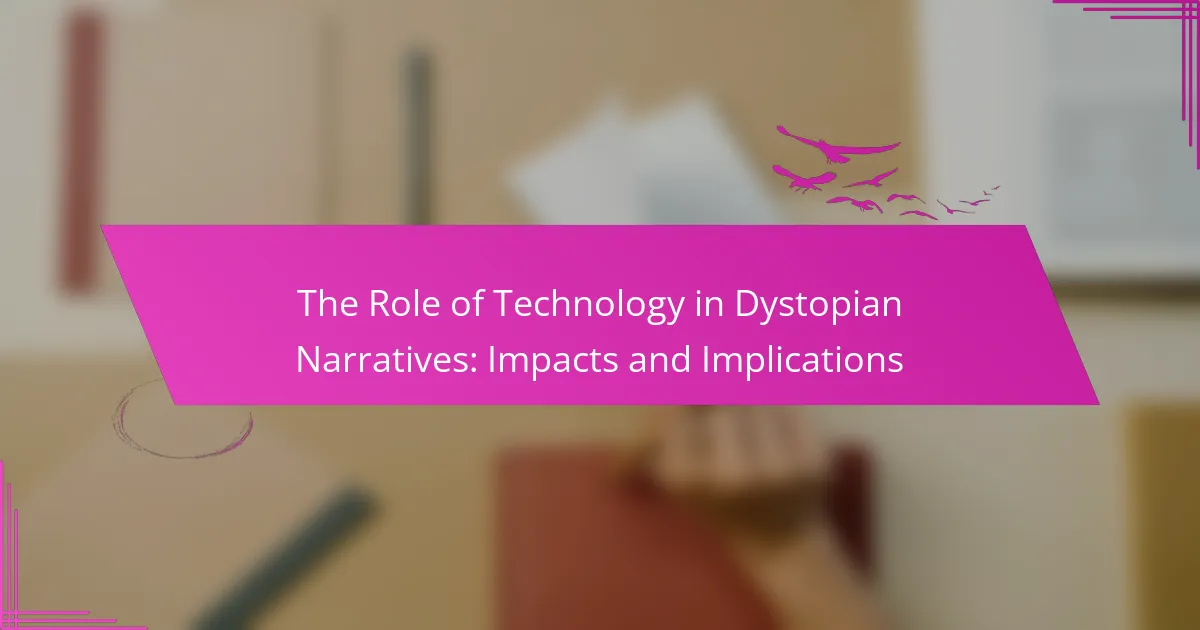Technology significantly shapes dystopian narratives by serving as a mechanism for control and societal decay. It manifests through surveillance systems, artificial intelligence, and biotechnology, highlighting themes of oppression and ethical dilemmas. These narratives critique contemporary technological advancements and their potential consequences, reflecting societal anxieties about privacy, inequality, and human relationships. By examining these elements, we can better understand the implications of unchecked technological growth in our world.
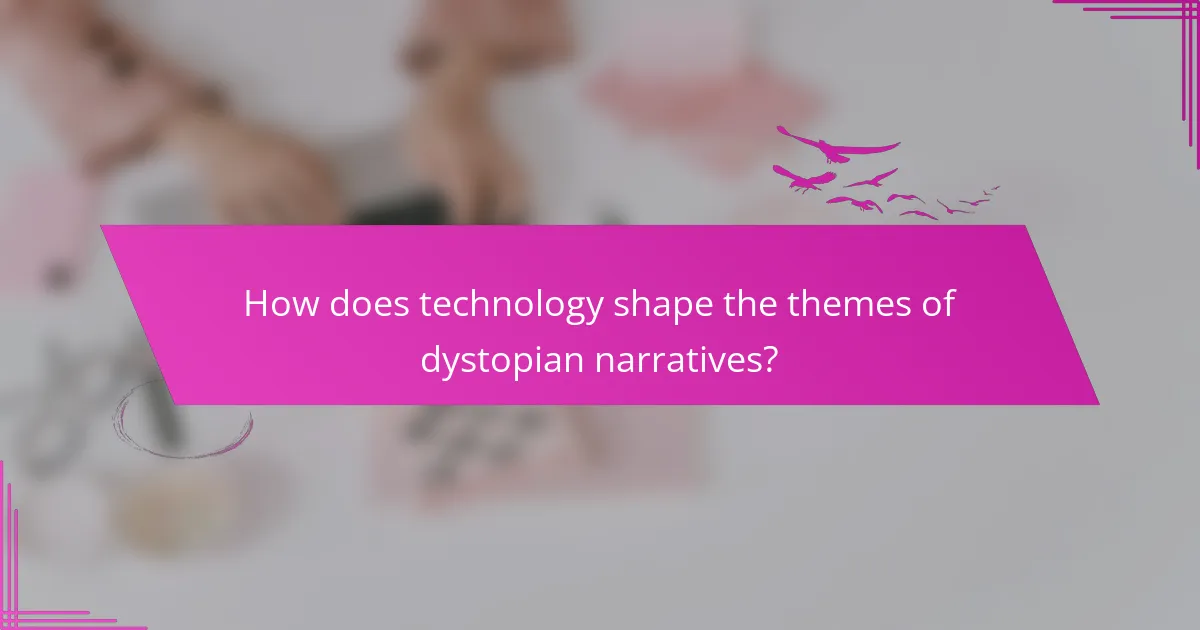
How does technology shape the themes of dystopian narratives?
Technology profoundly influences dystopian narratives by serving as a tool for control and a catalyst for societal decay. It often manifests as surveillance systems, artificial intelligence, and biotechnology, creating environments where human autonomy is compromised. For instance, in George Orwell’s “1984,” technology enables oppressive monitoring, illustrating the root attribute of pervasive surveillance. Unique attributes emerge in narratives like “Black Mirror,” where technology’s potential for both connection and alienation is explored. Rare attributes can include the portrayal of advanced technologies that offer hope, contrasting with the dominant themes of despair and control. Ultimately, technology shapes these narratives by reflecting contemporary anxieties about its impact on humanity.
What are the common technological elements found in dystopian stories?
Common technological elements in dystopian stories include surveillance systems, artificial intelligence, advanced weaponry, biotechnology, virtual reality, and environmental manipulation. These elements often reflect societal fears and critiques of technological advancements. Surveillance systems, such as omnipresent cameras, illustrate loss of privacy. Artificial intelligence can represent the loss of human control. Advanced weaponry often signifies conflict and oppression. Biotechnology explores ethical dilemmas in human enhancement. Virtual reality can depict escapism from harsh realities. Environmental manipulation highlights consequences of neglecting nature. Each element serves to enhance the narrative’s tension and provoke thought on technology’s role in society.
How do these elements reflect societal fears and anxieties?
Dystopian narratives often reflect societal fears and anxieties about technology’s impact on humanity. These stories highlight concerns over surveillance, loss of privacy, and the potential for dehumanization. As technology advances, fears of artificial intelligence surpassing human control become more prevalent. The portrayal of oppressive regimes using technology to manipulate and control populations resonates deeply with audience anxieties. Additionally, the rapid pace of technological change raises questions about societal adaptation and the ethical implications of innovation.
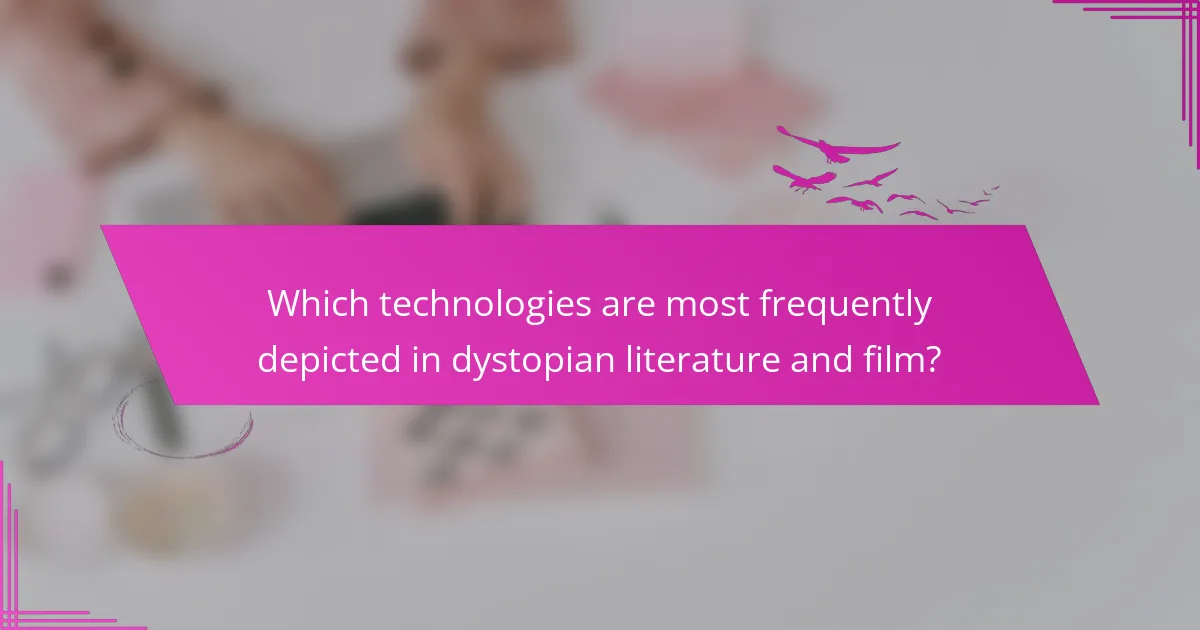
Which technologies are most frequently depicted in dystopian literature and film?
Technologies frequently depicted in dystopian literature and film include surveillance systems, artificial intelligence, biotechnology, and virtual reality. These technologies often highlight themes of control, dehumanization, and societal collapse.
Surveillance systems, such as drones and facial recognition, illustrate the loss of privacy and freedom. Artificial intelligence often represents both hope and danger, showcasing its potential to enhance life or dominate humanity. Biotechnology raises ethical questions about genetic manipulation and its implications for identity. Virtual reality serves as an escape from harsh realities, emphasizing the contrast between illusion and truth.
These technologies collectively reflect societal anxieties about the future and the consequences of unchecked advancement. Their portrayal encourages critical reflection on current technological trends and their potential trajectories.
How does artificial intelligence influence character development and plot progression?
Artificial intelligence significantly shapes character development and plot progression in dystopian narratives. It enhances complexity by creating multifaceted characters whose actions are driven by algorithms and data analysis. AI influences plot progression through predictive modeling, allowing narratives to explore various outcomes based on character decisions.
Moreover, AI-generated scenarios can introduce unique attributes, such as unexpected twists that challenge characters’ motivations. This technology fosters a deeper exploration of themes like identity and autonomy, reflecting societal concerns about technology’s impact on human life. As a result, the integration of AI in storytelling creates a richer, more engaging narrative experience.
What role does surveillance technology play in creating tension and conflict?
Surveillance technology intensifies tension and conflict by enabling constant monitoring and control. This pervasive observation fosters distrust among individuals and communities, leading to heightened anxiety and resistance. The fear of being watched can stifle free expression and dissent, creating an oppressive atmosphere. Additionally, surveillance tools can be exploited by authorities to suppress opposition, further escalating societal discord.
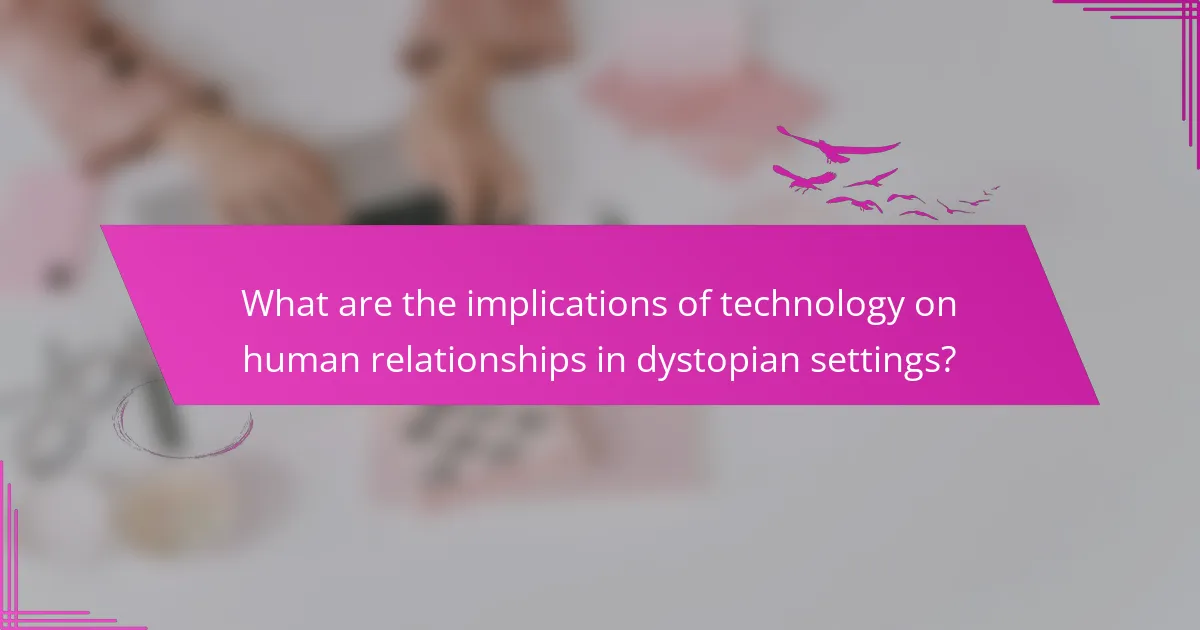
What are the implications of technology on human relationships in dystopian settings?
Technology in dystopian settings often leads to isolation and manipulation in human relationships. Surveillance and control diminish trust and intimacy. Social media can create false connections, while virtual interactions replace genuine human contact. These dynamics highlight the risks of technology undermining authentic relationships.
How does technology affect communication and social interaction?
Technology significantly alters communication and social interaction by enhancing connectivity while also fostering isolation. It enables instant messaging and social media, allowing individuals to connect globally. However, it can diminish face-to-face interactions, leading to superficial relationships. The unique attribute of technology in dystopian narratives often highlights this duality, showcasing both the benefits and the potential alienation caused by over-reliance on digital platforms. As a result, societal implications include changes in interpersonal dynamics and emotional disconnect.
What are the psychological impacts of technology on individuals in dystopian worlds?
Technology in dystopian worlds often leads to significant psychological impacts on individuals. These impacts include increased anxiety, feelings of isolation, and a diminished sense of agency. Surveillance technologies can create paranoia, while social media may foster disconnection despite increased connectivity. As a result, individuals may experience a distorted reality, struggling to form genuine relationships. The unique attribute of technology in these narratives is its role as both a tool for oppression and a means of resistance, influencing mental health outcomes in complex ways.
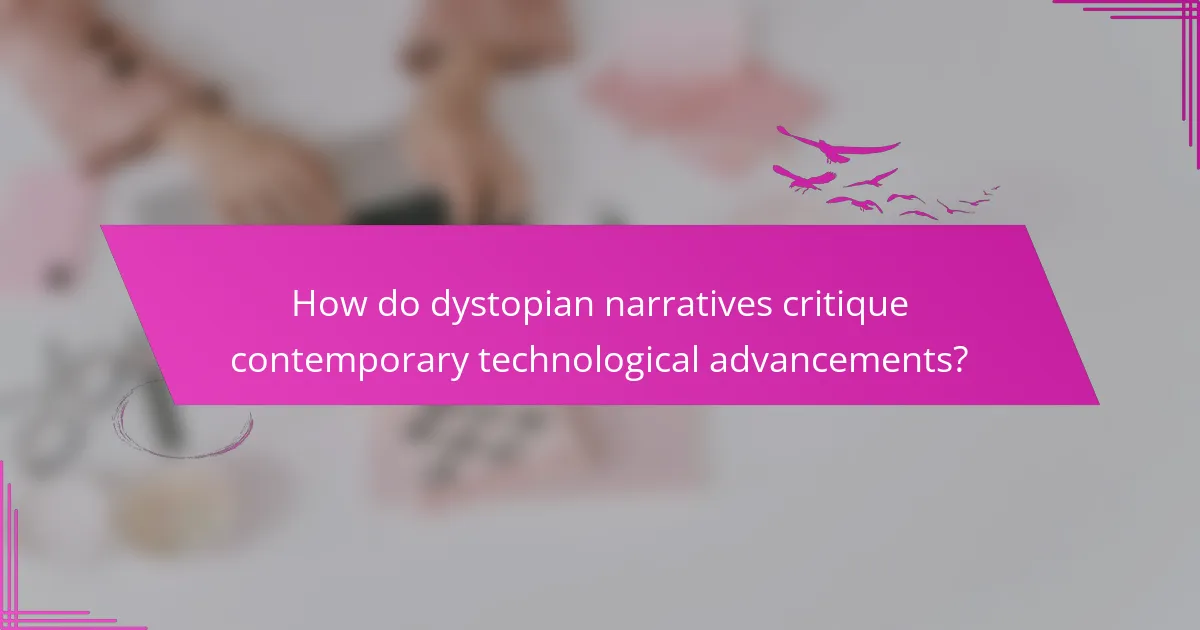
How do dystopian narratives critique contemporary technological advancements?
Dystopian narratives critique contemporary technological advancements by highlighting their potential dangers. These stories often depict technology as a tool for surveillance, control, and loss of individuality. For instance, in George Orwell’s “1984,” the omnipresent telescreen symbolizes invasive monitoring. This reflects concerns about privacy erosion in modern society, where technology can manipulate and monitor behavior.
Additionally, dystopian works like “Black Mirror” explore the unintended consequences of technological innovations. They illustrate how advancements intended to enhance life can lead to alienation and ethical dilemmas. This critique serves as a cautionary tale, urging society to consider the implications of unchecked technological growth.
Furthermore, these narratives often emphasize the disparity in access to technology, revealing how it can exacerbate social inequalities. For example, in “The Hunger Games,” technology is wielded by the elite to oppress the masses, mirroring real-world issues of digital divide and access to information.
Ultimately, dystopian narratives function as a lens through which we can scrutinize the trajectory of technological development, prompting critical reflection on its societal impacts and ethical considerations.
Which specific technologies are highlighted as potential threats?
Technologies highlighted as potential threats include artificial intelligence, surveillance systems, biotechnology, and social media manipulation. These technologies can undermine privacy, enable authoritarian control, and exacerbate social inequalities. For example, AI can perpetuate bias, while surveillance systems infringe on civil liberties.
What lessons can be learned from these critiques?
Critiques of technology in dystopian narratives reveal vital lessons about societal values and ethical boundaries. They highlight the dangers of unchecked technological advancement and its potential to erode human agency. These narratives often serve as cautionary tales, encouraging critical reflection on current technological trends and their implications for future society. By examining these critiques, we can better understand the balance needed between innovation and ethical responsibility.
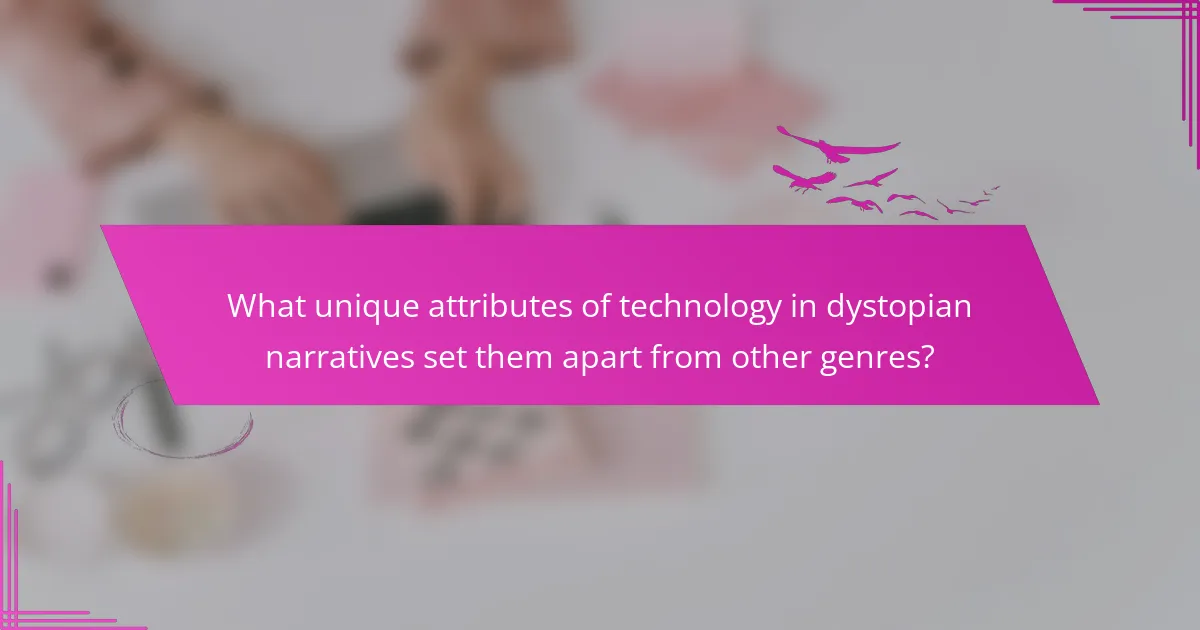
What unique attributes of technology in dystopian narratives set them apart from other genres?
The unique attributes of technology in dystopian narratives often highlight control, surveillance, and societal decay. These elements distinguish the genre by portraying technology as a tool of oppression rather than liberation. Dystopian settings frequently feature advanced surveillance systems that monitor citizens, emphasizing privacy loss. Additionally, technology often contributes to environmental degradation, showcasing its dual role in society’s downfall. Unlike other genres, dystopian narratives uniquely explore the ethical implications of technological advancements, prompting reflection on the future of humanity.
How do the portrayals of technology differ across various cultural contexts?
Portrayals of technology in dystopian narratives vary significantly across cultures. Cultural values shape how technology is depicted, influencing perceptions of its role in society.
In Western contexts, technology often represents oppression, surveillance, and loss of individuality. For example, George Orwell’s “1984” illustrates a society where technology monitors citizens, highlighting fears of authoritarian control.
Conversely, in some Eastern narratives, technology may symbolize progress and harmony. Works like “Ghost in the Shell” explore the integration of technology with humanity, suggesting a more nuanced relationship.
These contrasting portrayals reflect unique cultural anxieties and aspirations, shaping the implications of technology in society.
What are some rare technological concepts explored in lesser-known dystopian works?
Lesser-known dystopian works often explore rare technological concepts that challenge societal norms. These narratives frequently delve into advanced surveillance systems, artificial intelligence with emotional capabilities, and bioengineering that alters human perception.
For example, “The Windup Girl” by Paolo Bacigalupi presents a future where genetically modified organisms dominate food production, raising ethical questions about bioengineering. Similarly, “Parable of the Sower” by Octavia Butler introduces a unique technology that enables shared consciousness, impacting human relationships and societal structures.
These rare attributes highlight technology’s potential to reshape human experience in unexpected ways, emphasizing the complex implications of its integration into society.
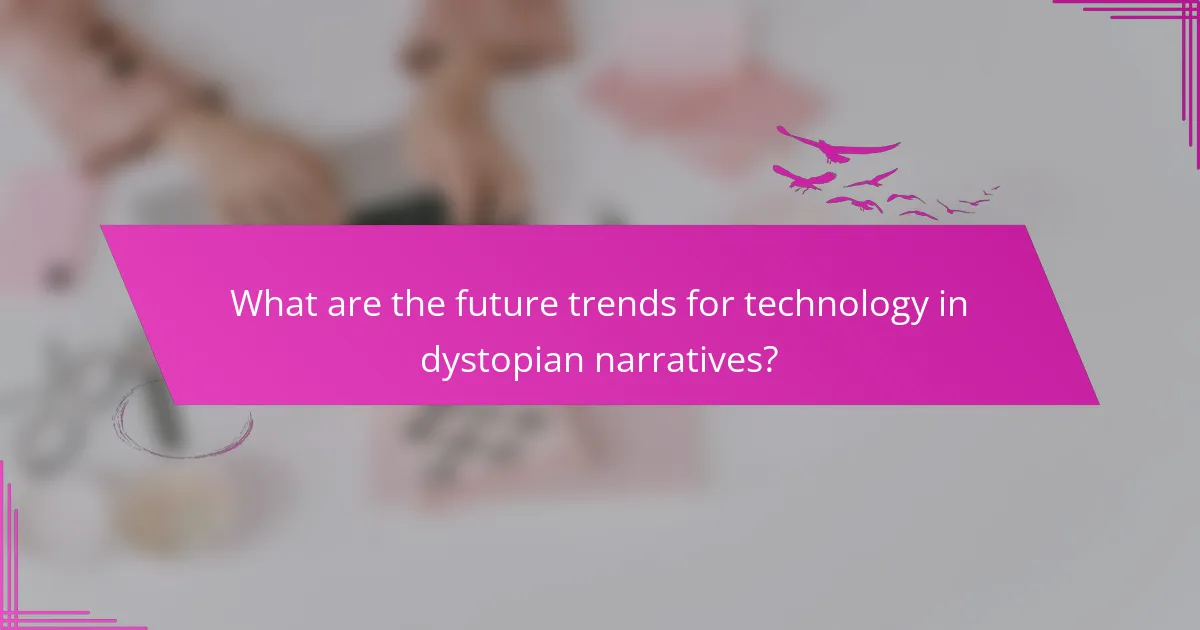
What are the future trends for technology in dystopian narratives?
Future trends for technology in dystopian narratives include increased surveillance, artificial intelligence dominance, and virtual reality escapism. These elements reflect societal fears and ethical dilemmas. For instance, advanced surveillance systems may lead to a loss of privacy, while AI could challenge human autonomy. Virtual reality might serve as an escape from harsh realities, raising questions about the nature of existence. These trends highlight the complex relationship between technology and humanity in speculative fiction.
How might emerging technologies reshape the genre in the coming years?
Emerging technologies will significantly reshape dystopian narratives by enhancing storytelling and interactivity. Innovations like virtual reality and artificial intelligence allow for immersive experiences that engage audiences on a deeper level. For instance, AI-generated content can create unique plotlines tailored to individual preferences, making each viewer’s experience distinct. Additionally, advancements in augmented reality can overlay dystopian elements onto the real world, blurring the lines between fiction and reality. These technologies will not only transform how stories are told but also how audiences connect with the themes and implications of dystopian scenarios.
What are the potential ethical considerations surrounding these technologies?
Ethical considerations surrounding technology in dystopian narratives include privacy invasion, autonomy erosion, and the potential for manipulation. These technologies often reflect societal fears, raising questions about surveillance and control. For instance, artificial intelligence can lead to biased decision-making, impacting marginalized groups disproportionately. Additionally, the use of technology for propaganda can distort reality, fostering misinformation. As a result, ethical frameworks must address these implications to ensure technology serves humanity positively.
What best practices can writers follow when incorporating technology into dystopian narratives?
Writers should focus on the nuanced portrayal of technology’s role in shaping dystopian societies. Emphasizing how technology influences social structures, personal identity, and ethical dilemmas enhances narrative depth. Integrating realistic technological advancements fosters believability. Exploring the consequences of technological dependence can create tension and provoke critical thought. Additionally, using technology as a symbol for control or liberation can enrich thematic layers in the story.
